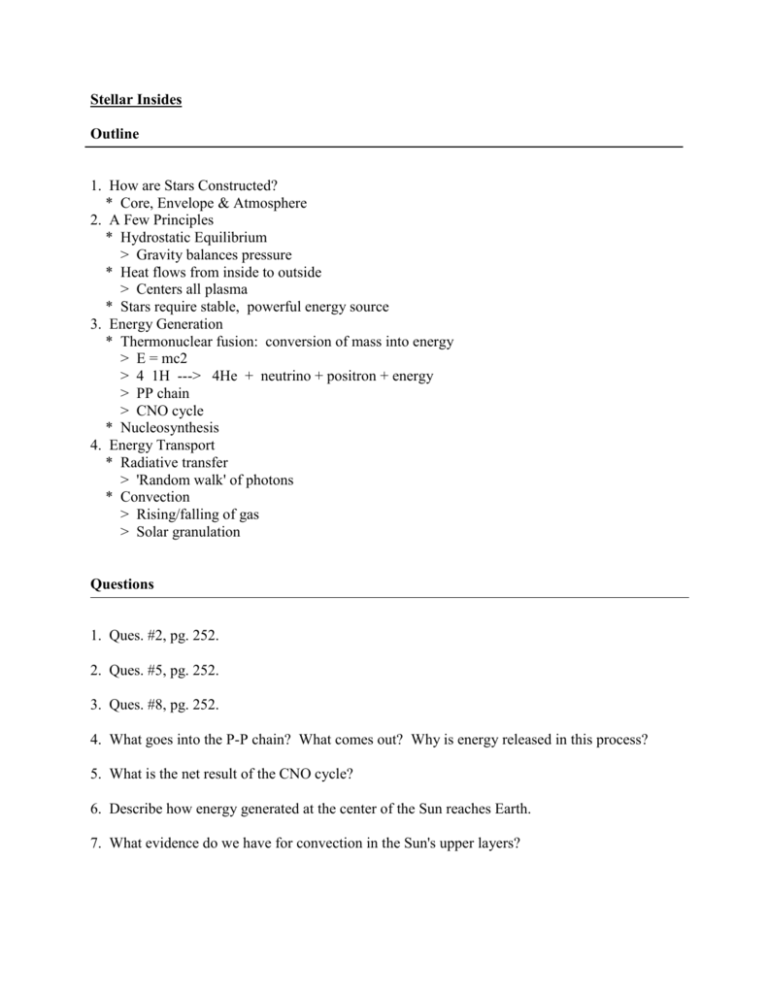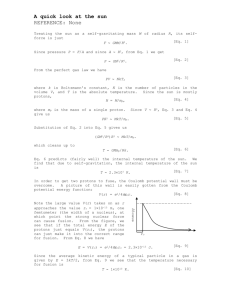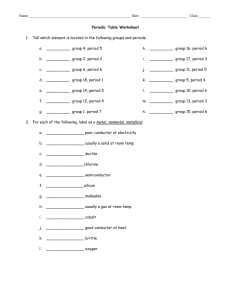Stellar Insides - courses.psu.edu
advertisement

Stellar Insides Outline 1. How are Stars Constructed? * Core, Envelope & Atmosphere 2. A Few Principles * Hydrostatic Equilibrium > Gravity balances pressure * Heat flows from inside to outside > Centers all plasma * Stars require stable, powerful energy source 3. Energy Generation * Thermonuclear fusion: conversion of mass into energy > E = mc2 > 4 1H ---> 4He + neutrino + positron + energy > PP chain > CNO cycle * Nucleosynthesis 4. Energy Transport * Radiative transfer > 'Random walk' of photons * Convection > Rising/falling of gas > Solar granulation Questions 1. Ques. #2, pg. 252. 2. Ques. #5, pg. 252. 3. Ques. #8, pg. 252. 4. What goes into the P-P chain? What comes out? Why is energy released in this process? 5. What is the net result of the CNO cycle? 6. Describe how energy generated at the center of the Sun reaches Earth. 7. What evidence do we have for convection in the Sun's upper layers? Answers 1. In gravitational (or hydrostatic) equilibrium, pressure (which tends to inflate a star) is balanced against gravity (which tends to shrink a star). Think of gas pressure at any depth as supporting the weight of all overlying material in the star. Naturally, as we go deeper in the star, the amount of overlying material increases, thus the pressure needed to support this material against gravity must increase. 2. Core: region of energy production. Reactions fusing hydrogen into helium (principally via the PP chain) release the nuclear energy that eventually produced the the photons that stream into space from the Sun's surface. Envelope: The lower envelope carries energy toward the surface via radiative transfer: photons bounce around between atoms, with the net flow toward the surface The upper envelope carryies energy toward the surface via convection: plumes of hot gas rise; adjacent plumes of cool gas fall. Atmosphere: Here photons stream into space. The lowest level - the photosphere - produces most of the light that we can see, and forms the effective 'surface' of the Sun. 3. Fusion in the Sun (and other main sequence stars) requires that protons get close enough to each other to bond together, via the strong nuclear force. The strong nuclear force works only when the protons get very close to each other. At larger distances, the protons feel the repulsive electrical force (protons carry positive charge). In order for the protons to get close to each other, they must be moving fast. Here's an analogy: imagine dropping a bowling ball on a spring. The greater the height from which the ball is dropped (thus the greater its speed), the more the spring is compressed. And so it is that the faster the protons are moving the closer together they can get. And the protons go faster as temperature increases. So we need high temperature for fusion to work. But we also need high density because we want collisions between protons to occur frequently enough to provide the star with the energy it needs. Higher density means we have more protons available to collide, thus we should have more collisions at higher density. 4. The net result of the PP chain is that four protons disappear, and a single helium nucleus (containing four particles) and energy come out. The energy released results from the fact that the single helium nucleus is slightly less massive than the sum of the masses of the four protons that combined to make the helium. This slight mass loss is converted into energy via Einstein's famous equation: E = mc2. 5. The net result of the CNO cycle is the fusion of 4 protons to make a single helium nucleus, plus energy. This is identical to the net result of the PP chain. These two reaction schemes represent different pathways to the same result. 6. Energy is converted from nuclear energy to heat energy in the Sun's core. This energy is then conducted to the surface of the Sun via photons (in the lower envelope) and convection (in the upper envelope). At the surface, this energy appears as photons that stream into space. 7. The Sun's photosphere appears 'granulated:' small bright regions are surrounded by darker zones. Within the bright regions, hot gas is moving upward. In the darker zones, cooler gas is moving upward.







